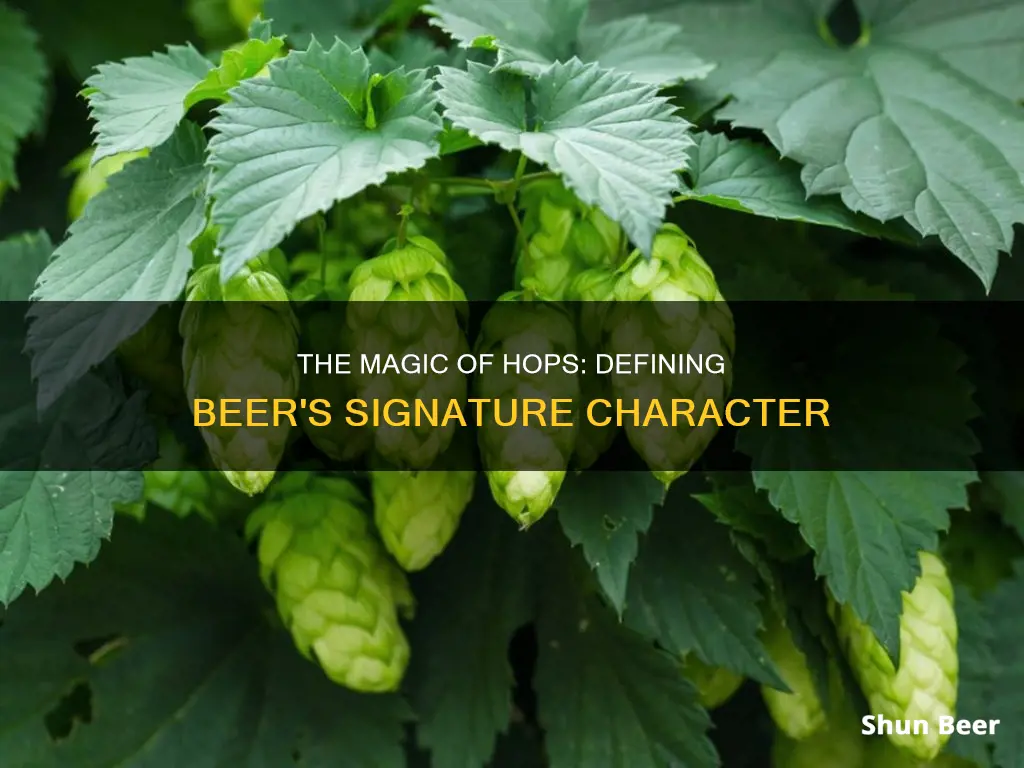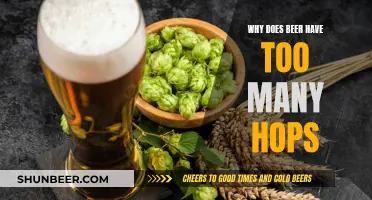
Hops are the flowers (also called seed cones or strobiles) of the hop plant Humulus lupulus, a member of the Cannabaceae family of flowering plants. They are used primarily as a bittering, flavouring, and stability agent in beer, to which they impart bitterness, floral, fruity, or citrus flavours and aromas. Hops are added to the boil stage of brewing, as it takes a long time to unleash the alpha acids that bitter and balance the sweetness of the malt.
What You'll Learn

Hops are flowers or cones of the Humulus lupulus plant
The hop plant is a vigorous, climbing, herbaceous perennial, usually trained to grow up strings in a field called a hopfield, hop garden, or hop yard when grown commercially. Many different varieties of hops are grown by farmers around the world, with different types used for particular styles of beer. Hops are divided into two very general varieties: bittering and aroma. Bittering hops will have higher alpha acids, making them more economical for bittering beer. Aroma hops will tend to have more essential oils that contribute much of what people understand as "hoppiness".
Hops are dioecious, meaning there are separate male and female plants. Only seedless female hop cones are used in the brewing industry, as male hop plants have very small cones that contain only a tiny fraction of the amount of resin that female cones contain. They also lack some of the essential aroma oils so prized by brewers and beer drinkers.
The hop flower, or cone, is botanically a "catkin". It is an inflorescence that contains a central support called a strig. The strig holds 20 to 60 bracteoles (petals/sepals) along its axis, each with two female floral parts at its base to form a cone-shaped flower. Tucked inside each cone are tiny yellow pods called lupulin, which contain resin and essential oils—the driving source of bitterness, aroma, and flavour in all your favourite beers.
Dry Hopping Beer: Timing and Techniques for Flavorful Brews
You may want to see also

They add bitterness, flavour and stability to beer
Hops are the flowers, or cones, of the hop plant Humulus lupulus. They are used primarily as a bittering, flavouring, and stabilising agent in beer.
Hops are added to the boil stage of brewing, as it takes a long time (around an hour) to release the "alpha" acids that bitter and balance the sweetness of the malt. Hops contain beta acids or lupulones, which are desirable for their aroma contributions to beer. The beta acids in hops are responsible for the citrus, piney, and grapefruit notes often found in IPAs and other hop-forward beers.
Hops also contain essential oils that contribute to the flavour and aroma of beer. These oils are highly volatile and can boil away, so brewers often add hops during fermentation (dry hopping) or after fermentation to bring out specific flavours or aromas in a particular beer.
The degree of bitterness imparted by hops depends on the degree to which alpha acids are isomerized during the boil. The longer the hops are boiled, the more bitter the beer will become as the aromatic compounds evaporate. The intensity of "hoppiness" in beer is a matter of beer style specifications and the personality of the brewer.
Hops also have a role in the stability of the finished product, as the acids act as a preservative, giving beer its freshness and head of foam for longer.
The Success Story of Tropical Hop Beers
You may want to see also

Hops are divided into two types: bittering and aroma
Hops are the flowers, or cones, of the hop plant, a member of the Cannabaceae family of flowering plants. They are primarily used as bittering, flavouring, and stabilising agents in beer. Hops are also used for various purposes in other beverages and herbal medicines.
The type of hop used depends on when it is added to the brewing process. Bittering hops are boiled for a longer period, typically 60-90 minutes, and often have inferior aromatic properties as the aromatic compounds evaporate. Aroma hops are typically added later in the process to prevent the evaporation of essential oils and are often added after the wort has cooled and while the beer ferments, in a technique known as "dry hopping".
In recent times, many hops are now being classified as "dual-purpose", meaning they can be used at any stage of the brewing process.
The Magic of Hop Extract in Beer Explained
You may want to see also

They are hardy plants grown all over the world
Hops are the flowers, or cones, of the hop plant Humulus lupulus, a member of the Cannabaceae family of flowering plants. They are hardy plants that can survive cold winters with temperatures as low as -30°C. Hops are grown all over the world, with commercial production taking place in both hemispheres between roughly 30 and 52 degrees latitude.
The first documented hop cultivation was in 736 in the Hallertau region of present-day Germany. However, hops have since been grown in many different regions, with notable historical production in England, Germany, the United States, and the Czech Republic. In the US, hops were first grown in colonial times, with commercial production beginning in 1629 in the Massachusetts Bay settlement. By the mid-1800s, New York controlled the largest US hop acreage, but production later shifted to the Pacific coast, particularly Washington, Oregon, and California. Today, the Pacific Northwest region, including the Yakima Valley, comprises approximately 96% of total US hop acreage.
Outside of the US, notable hop-growing regions include Hallertau in Germany, Žatec (Saaz) in the Czech Republic, and Kent in the UK. The principal production centres in the UK are in Kent, Herefordshire, and Worcestershire. Hops are also grown in most of the continental US and Canada, and cultivation for commercial production requires a particular environment. Hops thrive in moist temperate climates and prefer well-irrigated, potato-growing soils.
Many different varieties of hops are grown by farmers around the world, with different types used for particular styles of beer. The US is the world's largest producer of hops, accounting for 40% of world production and 39% of world hop acreage in 2019. However, hops are grown on a smaller scale in many other regions, and the diversity of growing areas contributes to the wide range of beer styles available today.
Mexican Beer and Hops: A Complex Relationship
You may want to see also

Hops are a key ingredient in IPAs, lagers and stouts
Hops are a key ingredient in IPAs, lagers, stouts, and many other types of beer. They are the flowers, or cones, of the hop plant Humulus lupulus, a member of the Cannabaceae family of flowering plants. They are used primarily as a bittering, flavouring, and stabilising agent in beer.
Hops add bitterness, flavour, and aroma to beer. They contain alpha acids or humulones, which are responsible for the bitter taste of beer. During the brewing process, humulones are converted into iso-alpha acids or isohumulones through boiling. This process of isomerization usually takes at least 45 minutes and is necessary for the bittering effect of hops. Hops also contain beta acids or lupulones, which contribute desirable aromas to the beer.
The essential oils in hops are responsible for the distinct hop aroma. Some common aromas include citrus, pine, mango, resin, melon, grapefruit, and floral notes. The intensity of the "hoppiness" in beer depends on the variety of hops used, the amount added, and the timing of their addition during the brewing process.
Hops are particularly important in IPAs, where they provide the signature bitterness and hoppy aroma that characterise the style. For example, Columbus hops are commonly used in IPAs to give them a classic bitter bite, while also adding earthy and spicy notes. Mosaic and Centennial hops can contribute berry, stone fruit, and citrus notes to IPAs, enhancing their flavour profile.
In lagers, hops also play a crucial role in adding bitterness and aroma. Tettnanger hops, for instance, are often used in lagers, imparting floral, earthy, and citrus notes. The choice of hops and their addition during the brewing process can vary depending on the desired flavour profile and regional characteristics of the lager.
Stouts, too, rely on hops for their distinctive flavour and aroma. While the roasty character of the dark grains takes centre stage, hops provide a supporting role in balancing the sweetness of the malt and adding subtle bitterness and aroma. The specific hops used and their proportions can vary depending on the brewer's preferences and the desired flavour profile of the stout.
In summary, hops are indeed a key ingredient in IPAs, lagers, and stouts. They provide bitterness, flavour, and aroma, enhancing the drinking experience and giving each style of beer its unique character.
The Magical Four Ingredients of Beer Brewing
You may want to see also
Frequently asked questions
Hops are the flowers, or cones, of the Humulus lupulus plant. They are a key ingredient in beer, providing its bitterness, aroma, and flavour.
Hops are associated with bitterness, but they can also have floral, fruity, citrus, spicy, piney, or earthy qualities.
Bittering hops have higher levels of alpha acids, which are released during the boil, making them more economical for adding bitterness. Aroma hops have more essential oils, which are highly volatile and tend to boil away, so they are added later in the brewing process to give a "hoppier" aroma.
Hops help to keep beer fresh for longer, stabilise the foam, and balance the sweetness of the malt. They also have antibacterial properties, which help to prevent spoilage.







